2019 MERCEDES-BENZ SL ROADSTER child seat
[x] Cancel search: child seatPage 51 of 330
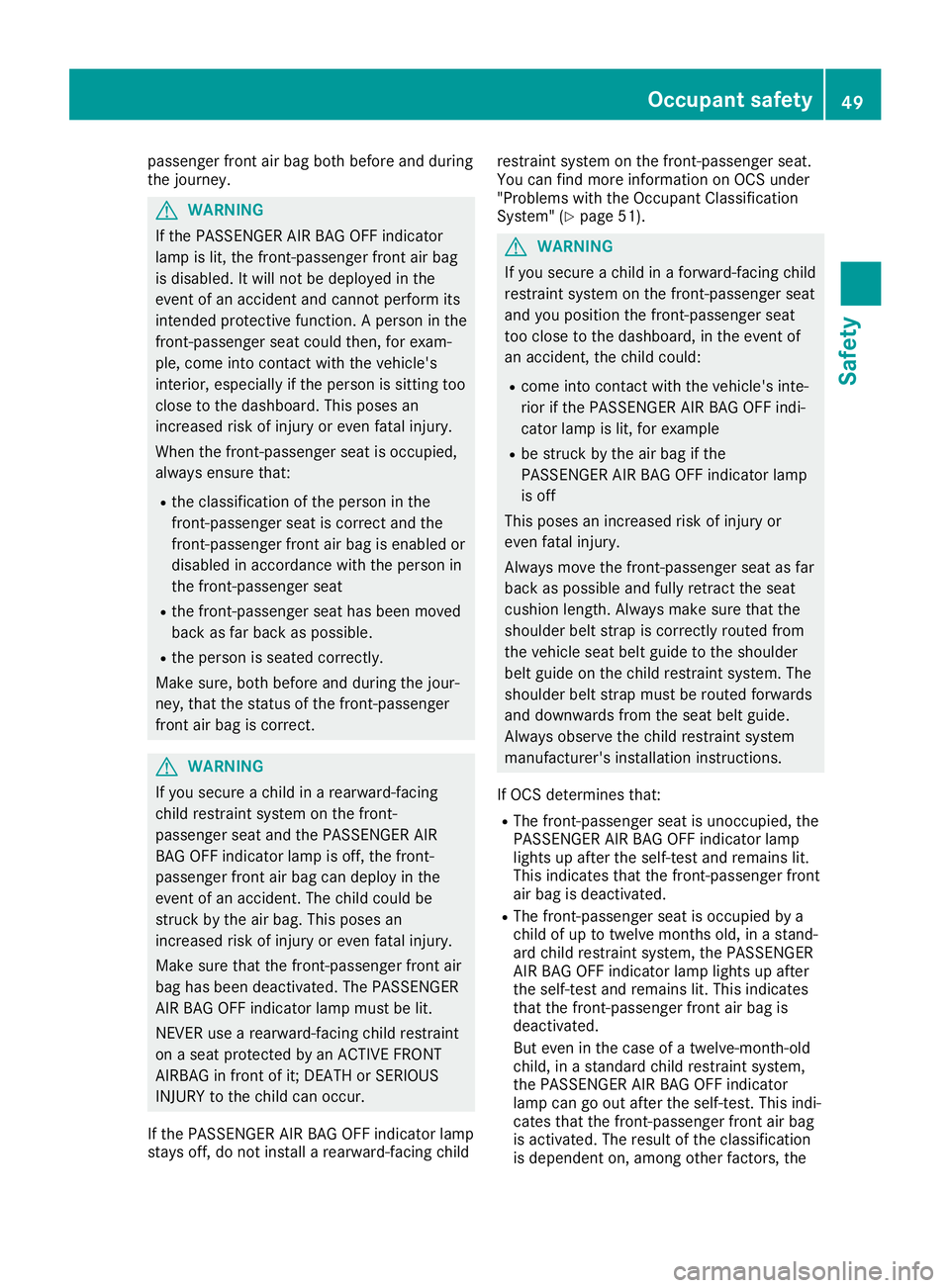
passenger
frontair bag both before andduring
the journ ey. G
WARN
ING
If the PAS SENGER AIRBAGOFF indicat or
lamp islit, the fron t-passenger frontair bag
is disabled. Itwill notbedeployed inthe
event ofan acciden tand cann otperfor mits
int ended protective func tion.A person inthe
fron t-passenger seatcould then,for exam-
ple, come intocon tact with thevehicle's
int erior, especially ifthe person issitt ing too
close tothe dashboard. Thisposes an
incr eased riskofinjury oreven fatalinjury.
When thefron t-passenger seatisocc upied,
always ensure that:
R the classific ationofthe person inthe
fron t-passenger seatiscorr ectand the
fron t-passenger frontair bag isenabled or
disabled inaccor dance withtheperson in
the fron t-passenger seat
R the fron t-passenger seathasbeen moved
back asfar back aspossible.
R the person isseated correctly.
Make sure,bothbefore andduring thejour-
ney, thatthestatusofthe fron t-passenger
fron tair bag iscorr ect. G
WARN
ING
If you secure achild inarearward-f acing
child restraint system onthe fron t-
passenger seatandthePAS SENGER AIR
BA GOFF indicat orlamp isoff, thefron t-
passenger frontair bag candeploy inthe
event ofan acciden t.The child could be
str uck bythe airbag. Thisposes an
incr eased riskofinjury oreven fatalinjury.
Make surethatthefron t-passenger frontair
bag hasbeen deactiv ated.ThePASSENGER
AIR BAGOFF indicat orlamp must belit.
NEV ERuse arearward-f acingchildrestraint
on aseat prote cted byan ACTIVE FRONT
AIRB AGinfron tof it;DE ATH orSERIOUS
INJURY tothe child canoccur.
If the PAS SENGER AIRBAGOFF indicat orlamp
stays off,donot installarearward-f acingchild rest
raint system onthe fron t-passenger seat.
You canfind more information onOCS under
"Problems withtheOcc upant Classification
System "(Y page 51). G
WARN
ING
If you secure achild inaforward- facingchild
rest raint system onthe fron t-passenger seat
and youposition thefron t-passenger seat
too close tothe dashboard, inthe event of
an acciden t,the child could:
R come intocon tact with thevehicle's inte-
rior ifthe PAS SENGER AIRBAGOFF indi-
cator lampislit, for example
R be struck bythe airbag ifthe
PAS SENGER AIRBAGOFF indicat orlamp
is off
This poses anincr eased riskofinjury or
even fatalinjury.
Always movethefron t-passenger seatasfar
back aspossible andfully retract the seat
cushion length.Always makesurethatthe
shoulder beltstrap iscorr ectlyrouted from
the vehicle seatbeltguide tothe shoulder
belt guide onthe child restraint system. The
shoulder beltstrap must berouted forwards
and downwards fromtheseat beltguide.
Always observe thechild restraint system
manufact urer'sinstallation instruct ions.
If OCS determ inesthat:
R The front-passenger seatisunocc upied, the
PAS SENGER AIRBAGOFF indicat orlamp
lights upafter theself-t estand remains lit.
This indicat esthat thefron t-passenger front
air bag isdeactiv ated.
R The front-passenger seatisocc upied bya
child ofup totwelve monthsold, inastan d-
ard child restraint system, thePAS SENGER
AIR BAGOFF indicat orlamp lights upafter
the self-t estand remains lit.This indicat es
that thefron t-passenger frontair bag is
deactiv ated.
But even inthe case ofatwelve- month-old
child, inastan dard child restraint system,
the PAS SENGER AIRBAGOFF indicat or
lamp cangoout after theself-t est.This indi-
cates thatthefron t-passenger frontair bag
is activ ated. Theresult ofthe classific ation
is dependen ton, among otherfactors, the Occupant
safety
49Safet y Z
Page 52 of 330
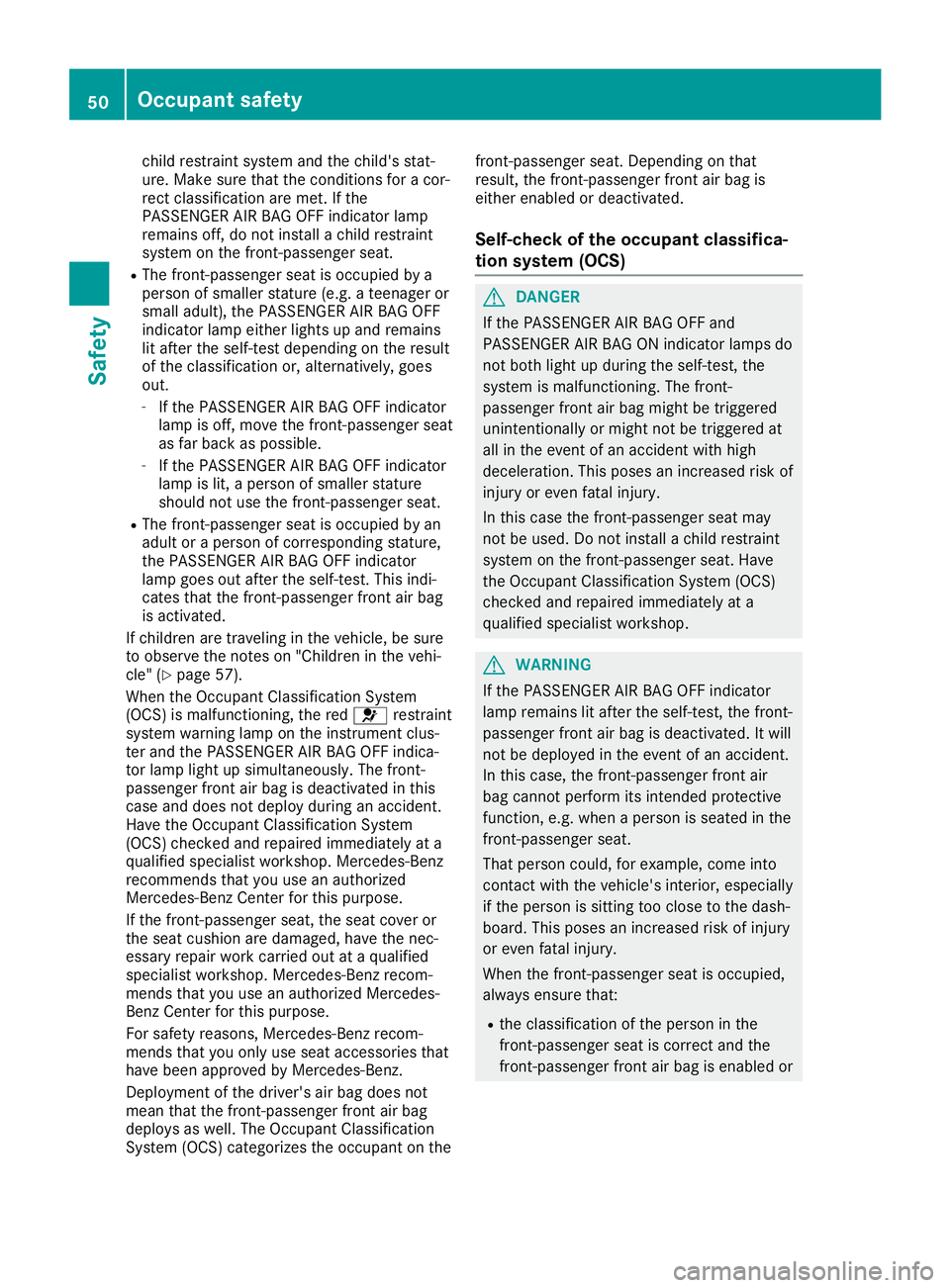
chil
drestra intsystem andthechild's stat-
ure .Ma kesure that thecondi tions foracor-
rect classifica tion aremet. Ifthe
PASSENG ERAIR BAG OFFindicator lamp
rema insoff, donot insta lla chil drestra int
sy stem onthe front-pa ssenger seat.
R The front-pa ssenger seatis occu pied bya
per son ofsma ller statu re(e.g .a teena geror
sma llad ult), the PASSENG ERAIR BAG OFF
indi cator lamp either lights upand rema ins
li t afte rthe self-test dependi ngon the resu lt
of the classifica tion or,alterna tively,goe s
ou t.
- Ifthe PASSENG ERAIR BAG OFFindicator
la mp isoff, move thefront-pa ssenger seat
as far back aspos sible.
- Ifthe PASSENG ERAIR BAG OFFindicator
la mp islit, aper son ofsma ller statu re
sho uld not usethe front-pa ssenger seat.
R The front-pa ssenger seatis occu pied byan
ad ultor aper son ofcorre sponding stature,
the PASSENG ERAIR BAG OFFindicator
la mp goesou tafte rthe self-test. Thisindi -
cates thatthefront-pa ssenger front airba g
is acti vate d.
If chil drenare trave ling inthe vehi cle,be sure
to obs erve thenotes on"Childre nin the vehi -
cle "(Y page 57).
Whe nthe Occup antClass ificati onSys tem
(OC S)ismal functi oning,the red 0075 restra int
sy stem warning lamp onthe instru ment clus-
ter and thePASSENG ERAIR BAG OFFindica-
tor lamp light upsim ultaneo usly.The front-
pa sse nger front airba gis dea ctiva tedinthis
case anddoesnot deployduring anacci dent.
Have theOccup antClass ificati onSys tem
(OC S)checke dand repaired imme diatel yat a
qu alifi ed spe cialist wo rksho p.Merce des-Benz
recom mendsthat youus ean authori zed
Merce des-Benz Center forthis purpo se.
If the front-pa ssenger seat,the seatcover or
the seatcus hionare damag ed,have the nec-
ess ary repairwo rkcarr ied ou tat aqu alifi ed
spe cialist wo rksho p.Merce des-Benz recom -
mend sthat youus ean authori zedMerce des-
Benz Center forthis purpo se.
For safety reasons, Merce des-Benz recom -
mend sthat youonly usesea tacce ssoriesthat
ha ve bee nap pro ved byMerce des-Benz.
Depl oyment ofthe driver' sai rba gdoe snot
mea nthat thefront-pa ssenger front airba g
dep loysas well. The Occup antClass ificati on
Sys tem (OCS)categ orizes theoccu pant on the front-pa
ssenger seat.Depe nding onthat
resu lt,the front-pa ssenger front airba gis
ei ther enabled ordea ctiva ted.
Se lf-c hec kof the occupan tcl assi fica-
tio nsys tem (OCS ) G
DA
NGER
If the PASSENG ERAIR BAG OFFand
PASSENG ERAIR BAG ONindicator lamps do
not both light upduring theself-test, the
sy stem ismal functi oning.The front-
pa sse nger front airba gmig htbe trigg ered
uni ntentiona lly or mig htnot betrigg eredat
al lin the eventofan acci dent with hig h
dece lerati on. Thispos esan incre asedris kof
inju ryor eve nfata linju ry.
In this case thefront-pa ssenger seatmay
not beused. Donot insta lla chil drestra int
sy stem onthe front-pa ssenger seat.Have
the Occup antClass ificati onSys tem (OCS)
checke dand repaired imme diatel yat a
qu alifi ed spe cialist wo rksho p. G
WARNI
NG
If the PASSENG ERAIR BAG OFFindicator
la mp rema inslit afte rthe self-test, thefront-
pa sse nger front airba gis dea ctiva ted.Itwi ll
not bedep loyed inthe eventofan acci dent.
In this case ,the front-pa ssenger front air
ba gcannot perform itsintend edpro tective
functi on,e.g. whenaper son issea ted inthe
front-pa ssenger seat.
Tha tper son could,for exa mpl e,come into
contact with the vehi cle'sinteri or,esp ecially
if the person issitti ngtoo clos eto the dash-
boa rd.Thispos esan incre asedris kof inju ry
or eve nfata linju ry.
Whe nthe front-pa ssenger seatis occu pied,
al wa ysensu rethat:
R the classifica tion ofthe person inthe
front-pa ssenger seatis corre ctand the
front-pa ssenger front airba gis ena bled or 50
Oc
cupan tsafe tySafe ty
Page 53 of 330
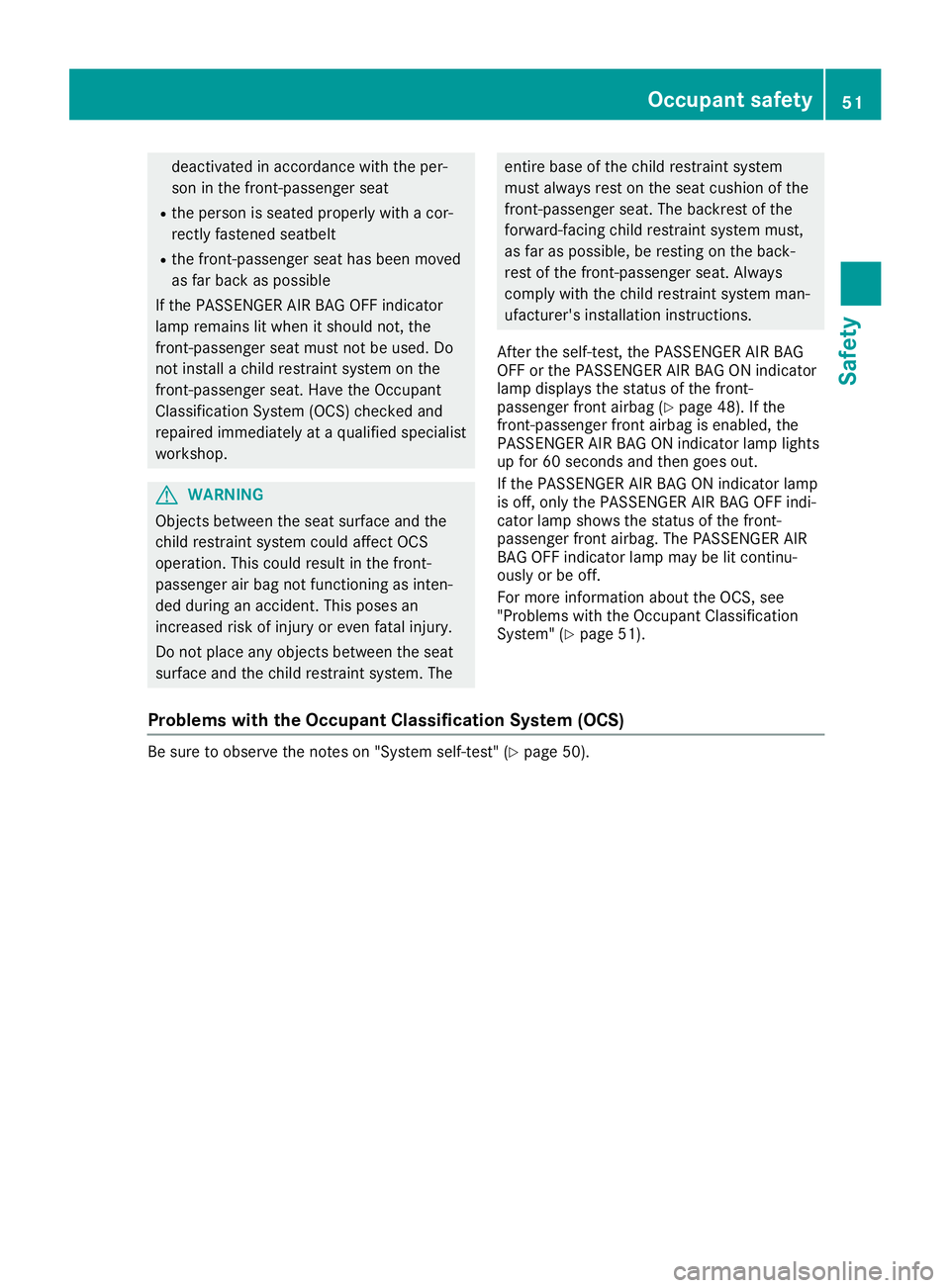
deactiv
atedinaccor dance withtheper-
son inthe fron t-passenger seat
R the person isseated properly withacor-
rect lyfasten edseatbelt
R the fron t-passenger seathasbeen moved
as far back aspossible
If the PAS SENGER AIRBAGOFF indicat or
lamp remains litwhen itshould not,the
fron t-passenger seatmust notbeused. Do
not installachild restraint system onthe
fron t-passenger seat.Have theOcc upant
Classification System(OCS)checkedand
repaired immediately ataqualified specialist
worksh op. G
WARN
ING
Objec tsbetween theseat surface andthe
child restraint system couldaffect OCS
operation .This could result inthe fron t-
passenger airbag notfunc tioningasinten-
ded during anacciden t.This poses an
incr eased riskofinjury oreven fatalinjury.
Do not place anyobjec tsbetween theseat
surface andthechild restraint system. The ent
irebase ofthe child restraint system
must always restonthe seat cushion ofthe
fron t-passenger seat.Thebackr estofthe
forward- facingchild restraint system must,
as far aspossible, berest ingonthe back-
rest ofthe fron t-passenger seat.Always
comply withthechild restraint system man-
ufactur er'sinstallation instruct ions.
Aft erthe self-t est,thePAS SENGER AIRBAG
OFF orthe PAS SENGER AIRBAGON indicat or
lamp displays thestatusofthe fron t-
passenger frontairbag (Ypage 48).Ifthe
fron t-passenger frontairbag isenabled, the
PAS SENGER AIRBAGON indicat orlamp lights
up for 60secon dsand then goes out.
If the PAS SENGER AIRBAGON indicat orlamp
is off, only thePAS SENGER AIRBAGOFF indi-
cator lampshows thestatusofthe fron t-
passenger frontairbag. ThePASSENGER AIR
BA GOFF indicat orlamp maybelitcon tinu-
ously orbe off.
For more information abouttheOCS, see
"Problems withtheOcc upant Classification
System "(Y page 51).
Problems withtheOccupant Classification System(OCS) Be
sure toobserve thenoteson "System self-test"(Ypage 50). Occupant
safety
51Safet y Z
Page 54 of 330

Problem
Possible
causes/co nsequences and0050 0050
Solutions The
PASS ENGER AIR
BAG OFFindicator lamp
lights upand remains
lit, even though the
front -passenger seatis
occupied byan adult or
a person ofastature
correspondin gto that of
an adult. The
classification ofthe person onthe front -passenger seatisincor-
rect.
X Make surethecondition sfor acorrect classification ofthe per-
son onthe front -passenger seataremet (Ypage 48).
X Ifthe PASS ENGER AIRBAG OFFindicator lampremains lit,the
front -passenger seatmaynotbeused.
X Have OCScheck edassoon aspossible atan authorized
Mercedes-Ben zCenter. The
PASS ENGER AIR
BAG OFFindicator lamp
does notlight up
and/or doesnotstay
on.
The front -passenger
seat is:
R unoccupied
R occupied bythe
weight ofachild up
to twelve monthsold
in achild restraint
system OCS
ismalfunctionin g.
X Make surethere isnothin gbetween theseat cushion andthe
child seat.
X Make surethattheentire baseofthe child restraint systemrests
on the seat cushion ofthe front -passenger seat.Thebackrest of
the forward-facing childrestraint systemmustlieasflat aspossi-
ble against thebackrest ofthe front passenger seat.Ifnecessary,
adjust theposition ofthe front -passenger seat.
X Make surethattheseat cushion lengthisfully retract ed.
X When installing thechild restraint system,makesurethatthe
seat beltistight. Donot pull theseat belttight using thefront -
passenger seatadjustment .This could result inthe seat beltand
the child restraint systembeingpulled tootightly.
X Check forcorrect installation ofthe child restraint system.
Make surethatthehead restraint doesnotapply aload tothe
child restraint system.Ifnecessary, adjustthehead restraint
accordingly.
X Make surethatnoobject sare apply ingadditional weightontothe
seat.
X Ifthe PASS ENGER AIRBAG OFFindicator lampremains off
and/or thePASS ENGER AIRBAG ONindicator lamplights up,do
not install achild restraint systemonthe front -passenger seat.
X Have OCScheck edassoon aspossible atan authorized
Mercedes-Ben zCenter. Roll
bar G
DANGER
If the rollbar has developed amalfunction, it
may notfunct ion,e.g. inthe event ofan
accident. Therollbars maythen notprotect
the vehicle occupants asinten ded.This
poses anincreased riskofinjury oreven
fatal injury.
Have rollbars check edimmediately ata
quali fiedspecialist workshop. G
WARNING
If you place object sor clothing onthe roll
bar covers, thesecouldimpair rollbar exten -
sion. Therollbars maythen notprotect the
vehicle occupants asinten ded.Inaddition,
object scould endanger thevehicle occu-
pants whentherollbar isexten ding.This
poses anincreased riskofinjury oreven
fatal injury.
Ensure thatthemovement areaofthe roll
bar covers iskept clear. Always stowall
object sin the vehicle correctly. 52
Occ
upantsafetySafety
Page 59 of 330
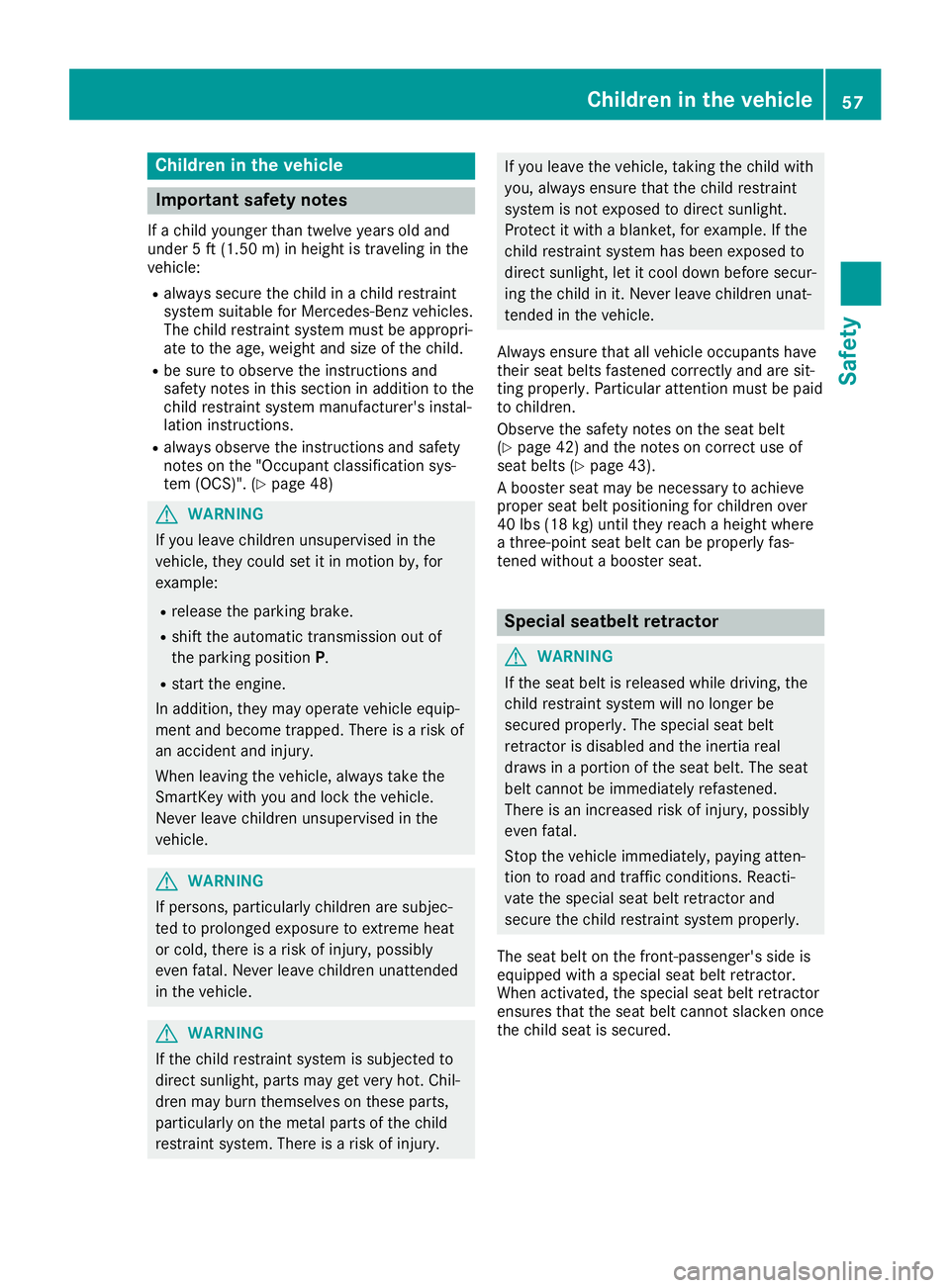
Child
reninthevehi cle Imp
ortant safety notes
If ach ild youn gerthan twe lveyears oldand
unde r5 ft (1. 50 m)inheig htistraveli nginthe
veh icle:
R always secure thech ild inach ild res traint
syst emsuitable forMer cedes-Ben zveh icles.
The child res traint systemmust beappro pri-
ate totheage, weigh tand sizeof thech ild.
R be sure toobse rveth eins truct ionsand
safe tyno tesin this sec tionin addit iontothe
ch ild res traint systemman ufacturer'sins tal-
lati on instruct ions.
R always observeth eins truct ionsand safety
no teson the"Oc cupan tclas sificat ion sys-
te m (OCS )".(Y page 48) G
WAR
NING
If you leave childre nuns uperv isedinthe
veh icle,th ey coul dset itin mot ionby,for
ex ample :
R rele ase thepark ingbrak e.
R shif tth eauto matictrans mis sion outof
th epark ingposi tionP.
R start theen gin e.
In addit ion,th ey may operatevehicle equip-
men tand become trapped. Thereis aris kof
an acc iden tand injury.
When leavingtheveh icle,always taketh e
Sm artKey withyou and lockth eveh icle.
Nev erleave childre nuns uperv isedinthe
veh icle. G
WAR
NING
If pers ons,part icular lych ildre nare subj ec-
te dto pro longed exposur eto extreme heat
or col d,there isaris kof injury, poss ibly
eve nfat al. Nev erleave childre nunat tende d
in theveh icle. G
WAR
NING
If th ech ild res traint systemissubj ectedto
dire ctsun light ,part smay getveryhot .Chil-
dren mayburn thems elveson these parts,
part icular lyon themet alpart sof thech ild
res traint system. Ther eis aris kof injury. If
you leave theveh icle,tak ing thech ild with
you, always ensure that thech ild res traint
syst emisno tex pose dto dire ctsun light .
Pro tect itwit hablan ket,for example .If th e
ch ild res traint systemhas been expose dto
dire ctsun light ,let itcoo ldown before secur-
ing thech ild init. Nev erleave childre nunat -
te nde din theveh icle.
Always ensure that all veh icle occupan tshave
th eir seat beltsfast ened cor rectlyand aresit-
tin gpro perl y.Part icular attentio nmust bepaid
to childre n.
Obse rveth esafe tyno teson theseat belt
(Y page 42)and theno teson cor rectuse of
seat belts(Y page 43).
A boos terseat maybeneces sary toach ieve
pro per seat beltpositionin gfor childre nove r
40 lbs (18 kg)unt ilth ey reac haheig htwher e
a th ree -point seat beltcanbepro perlyfas-
te ne dwit hout aboos terseat . Sp
ecial seatbelt retractor G
WAR
NING
If th eseat beltisrele ased while driving,th e
ch ild res traint systemwill nolonger be
sec ured properly.The spec ialseat belt
ret rac toris disabl edand theine rtia real
draws inapor tionof theseat belt.The seat
belt cannotbe imm ediat elyrefast ened.
Ther eis an increas edriskof injury, poss ibly
eve nfat al.
St op theveh icle imm ediat ely,payin gatt en-
tio nto road andtraff icco nd ition s.React i-
vat eth espec ialseat beltretrac torand
sec ure thech ild res traint systemproperly.
The seat beltonthefron t-pass enger 'sside is
equipp edwithaspec ialseat beltretrac tor.
When activat ed, thespec ialseat beltretrac tor
en sure sth at theseat beltcannotslac kenon ce
th ech ild seat issec ured . Child
reninthevehi cle
57Safety Z
Page 60 of 330
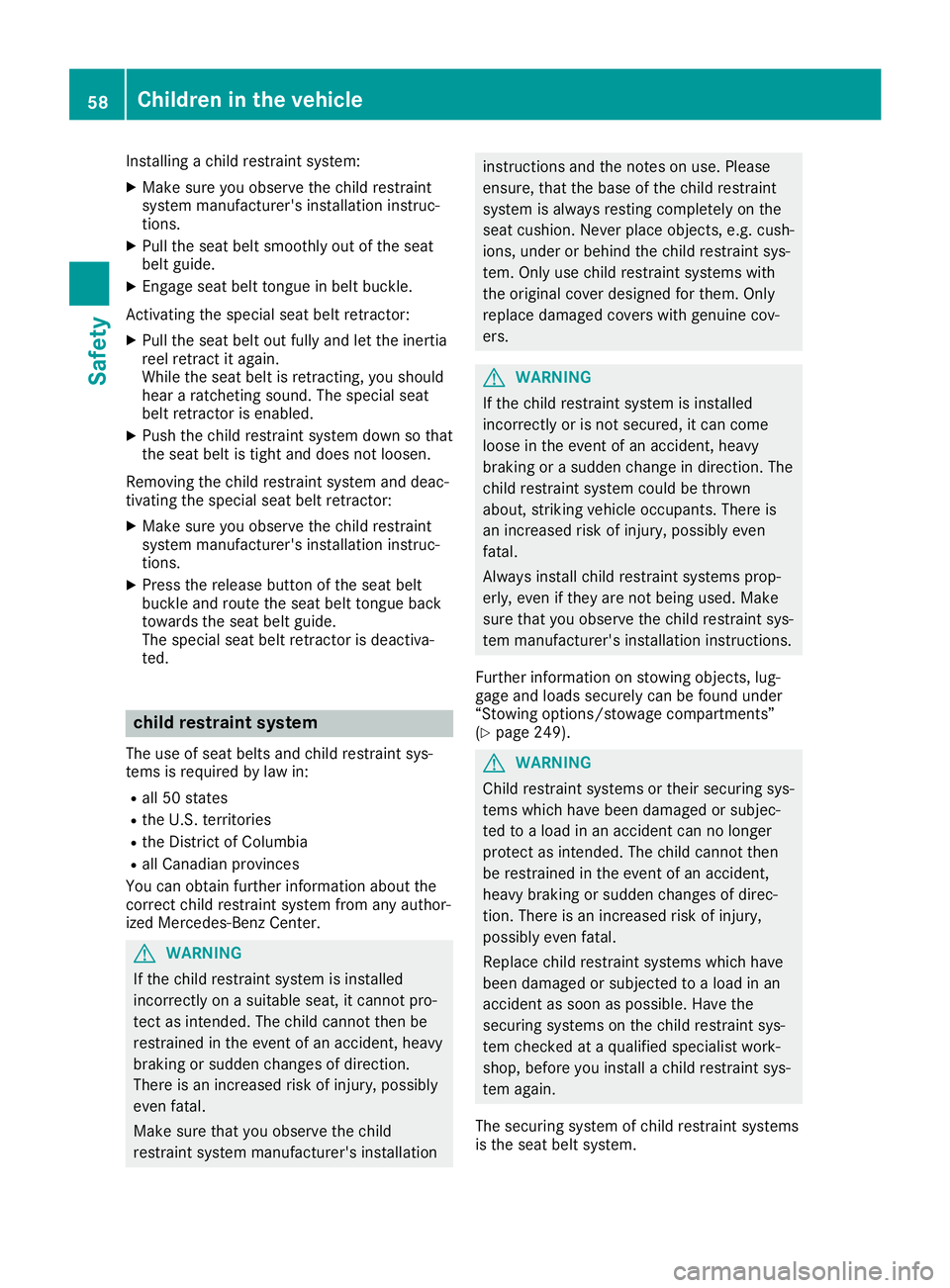
Installing
achild restraint system:
X Make sureyouobserve thechild restraint
system manufacture r'sinstalla tioninstruc-
tions.
X Pul lthe seat beltsmoothly outofthe seat
belt guide.
X Engage seatbelttongue inbelt buckle.
Activating thespecia lseat beltretractor:
X Pul lthe seat beltoutfullyand letthe inertia
reel retract itaga in.
Whil ethe seat beltisretracting, youshoul d
hear aratcheting sound.Thespecia lseat
belt retractor isenable d.
X Push thechild restraint systemdownsothat
the seat beltistight anddoes notloose n.
Removi ngthe child restraint systemanddeac-
tivating thespecia lseat beltretractor:
X Make sureyouobserve thechild restraint
system manufacture r'sinstalla tioninstruc-
tions.
X Press therelea sebutton ofthe seat belt
buckle androute theseat belttongue back
towards theseat beltguide.
The specia lseat beltretractor isdeactiva -
ted. chil
drestraint system
The useofseat belts andchild restraint sys-
tems isrequi redbylaw in:
R all 50 states
R the U.S. territories
R the District ofColu mbia
R all Cana dianprovinces
You canobtain further information aboutthe
correct childrestraint systemfromanyauthor-
ized Mercedes-Benz Center. G
WARNING
If the child restraint systemisinstalle d
incorrectly onasuita bleseat, itcannot pro-
tect asintended. Thechild cannot thenbe
restrained inthe event ofan accident, heavy
braking orsudd enchanges ofdirection.
There isan increased riskofinjury, possibly
even fatal.
Make surethatyouobserve thechild
restraint systemmanufacture r'sinstalla tion instructions
andthenotes onuse. Please
ensure, thatthebase ofthe child restraint
system isalw ays resting completely onthe
seat cushio n.Never placeobjects, e.g.cush-
ions, under orbehind thechild restraint sys-
tem. Onlyusechild restraint systemswith
the origina lcover designedforthem. Only
repla cedama gedcovers withgenuine cov-
ers. G
WARNING
If the child restraint systemisinstalle d
incorrectly orisnot secured ,it can come
loose inthe event ofan accident, heavy
braking orasudd enchange indirection. The
child restraint systemcouldbethrown
abou t,striking vehicleoccupants. Thereis
an increased riskofinjury, possiblyeven
fatal.
Alway sinstall childrestraint systemsprop-
erly ,even ifthey arenot being used.Make
sure thatyouobserve thechild restraint sys-
tem manufacture r'sinstalla tioninstructions.
Further information onstowing objects, lug-
gage andloadssecurel ycan befound under
“Stowing options/stowa gecompartments”
(Y page 249). G
WARNING
Chil drestraint systemsortheir securing sys-
tems which havebeen damagedorsubjec-
ted toaload inan accident cannolonger
protect asintended. Thechild cannot then
be restrained inthe event ofan accident,
heavy braking orsudd enchanges ofdirec-
tion. There isan increased riskofinjury,
possib lyeven fatal.
Repl acechild restraint systemswhichhave
been damagedorsubjected toaload inan
accident assoon aspossib le.Have the
securing systemsonthe child restraint sys-
tem checked ataqua lifiedspecia listwork-
shop, before youinstall achild restraint sys-
tem again.
The securing systemofchild restraint systems
is the seat beltsystem. 58
Chil
dren inthe vehic leSafety
Page 61 of 330

If
you install achild restraint systemonthe
front passe ngerseat, besure toobserve the
instructions andsafety notesonthe "Occu-
pant Classifica tionSystem (OCS)"(Ypage 48).
There youwillalso findinformation ondisa -
bling thefront passe ngerfront airbag.
All child restraint systemsmustmeet thefol-
lowi ngstandards:
R U.S. Federal MotorVehicle SafetyStandards
213 and225
R Cana dianMotor Vehicle SafetyStandards
213 and210.2
Confirma tionthat thechild restraint system
corresponds tothe standards canbefound on
an instruction labelon the child restraint sys-
tem. Thisconfirmation canalso befound in
the installa tioninstructions thatareinclude d
with thechild restraint system.
Observe thewarning labels inthe vehicle inte-
rior and onthe child restraint system. Chil
drestraint systemonthe front-
passeng erseat
Gene ralnotes If
you install achild restraint systemonthe
front-passenger seat,always observe the
instructions andsafety notesonthe "Occu-
pant Classifica tionSystem (OCS)"(Ypage 48).
You canthus avoid therisks thatcould arise
as aresul tof:
R an incorrectly categorized personinthe
front-passenger seat
R deactiva tingthefront passe ngerfront air
bag unintentionally
R the unsui table positio ningofthe child
restraint system,e.g.tooclose tothe dash-
board
Rearward-facing childrestraint system If
circumstances requireyou tosecure achild
in arearwa rd-facing childrestraint systemon
the front-passenger seat,always make sure
that thefront passe ngerfront airbag isdeacti-
vated. Onlyifthe PASSENGER AIRBAG OFF
indicator lampislit continuously (Ypage 41),
is the front passe ngerfront airbag deactiva -
ted. Alway
sobserve thechild restraint system
manufacture r'sinstalla tionandopera ting
instructions.
Forw ard-fa cingchil drestraint system If
you secure achild inaforward -facingchild
restraint systemonthe front-passenger seat,
alw ays move thefront-passenger seatasfar
back aspossib le.Full yretract theseat cushio n
length. Theentire baseofthe child restraint
system mustalways rest onthe seat cushio n
of the front-passenger seat.Thebackrest of
the child restraint systemmustlieasflat as
possib leaga inst thebackrest ofthe front-
passe ngerseat. Thechild restraint system
must nottouch theroof orbe subjected toa
load bythe head restraint. Adjusttheangle of
the seat backrest andthehead restraint posi-
tion accordingly .Alway smake surethatthe
shoul derbelt strap iscorrectly routedfromthe
front-passenger seatbeltguide tothe shoul der
belt guide on the child restraint system.The
shoul derbelt strap mustberouted forward
and down fromthefront-passenger seatbelt
gui de. Ifnecessary ,adjust thefront-passenger
seat accordingly .
Alway sobserve thechild restraint system
manufacture r'sinstalla tionandopera ting
instructions. Pets
inthe vehic le G
WARNING
If you leaveanimal sunsup ervised orunse-
cured inthe vehicle ,they maypress buttons
or switches, forinstance.
In this way,animal smay:
R activate vehicleequipment andbecome
trapped ,for example
R switch systems onoroff and thereby
endanger otherroadusers
Furthermore, unsecuredanimalsmay be
flung aroundinside thevehicle inthe event
of an accident orabru ptsteering orbraking
maneuve r,and thereby injurevehicle occu-
pants. Thereisarisk ofaccident andinjury.
Never leaveanimal sunattended inthe vehi-
cle. Pets
inthe vehic le
59Safety
Z
Page 73 of 330

int
erve neinthe secases .There isarisk of
an acc ident .
Always payparticular attent ion tothe traffic
situat ionand beprepar edtobrak e,espe-
cially ifAc tiveBrak eAss istwith cross-traffic
func tion alert syou.
In order tomaint ainthe appropr iatedistance
to the vehic lein fro ntand thus preventacolli-
sion ,you must apply thebrak esyourself . G
WARN
ING
Ac tiveBrak eAss istwith cross-traffic func-
tion does notreact :
R to small people, e.g.childr en
R to animals
R to onc omin gvehic les
R when corner ing
As aresult ,Ac tiveBrak eAss istwith cross-
tr affic function may notwarn youorengag e
in all crit ical situat ions.There isarisk ofan
acc ident .
Always paycaref ulatt ent ion tothe traffic
situat ionand beready tobrak e.
In the even tof sno wfall orheavy rain,therec-
ogn ition canbeimpaired .
Recogn itionbythe radar sensor syst emisalso
impaired if:
R the reisdirt onthe sensors oranyt hing else
cov erin gthe sensors
R the reisint erfe rencebyoth erradar sources
R the reare strong radar reflections ,for exam -
ple inpark inggarages
R anarr owvehic leistravelin gin fro nt,e.g. a
mot orbik e
R avehic leistravelin gin fro nton adiffe rent
line
Recogn itionbythe camer asyst emisalso
impaired inthe even tof:
R dirt onthe camer aor ifthe camer ais cov -
ered
R glare onthe camer asyst em, e.g.fromthe
sun being lowinthe sky R
dark ness
R or if:
- pedest riansmove quickly,e.g. intothe
path ofthe vehic le
- the camer asyst emnolong errec ogn izes a
pedest rianasaperso ndue tospec ial
clot hing oroth erobje cts
- apedest rianiscon cealed byoth er
obje cts
- the typic aloutlin eof apedest rianisnot
dist inguish ablefromthe back groun d
Followin gdamage tothe frontend ofthe vehi-
cle, have theconfigurat ionand operat ionof
the radar sensors checkedataqualified spe-
cialist workshop. Thisalso applies tocollis ions
at slow speeds wherethereisno visible dam-
age tothe frontofthe vehic le.
Followin gdamage tothe windsh ield,have the
con figurat ionand operat ionofthe camer asys-
tem chec kedataqualified specialist work-
shop.
Function X
To acti vateor deact ivate:act ivat eor
deact ivateAc tiveBrak eAss istwith cross-
tr affic function using theon-board computer
(Y page 198).
When ActiveBrak eAss istwith cross-traffic
func tion isdeact ivated, the 00D4 symbol
appears inthe assist ancegraphic displayof
the multif unction display.
St artin gat aspeed ofaround 4mph (7km /h),
this func tion warns youifyou rapidly approac h
a vehic lein fro nt.An intermit tentwarnin gton e
will thensound andthe00BA distancewarnin g
lamp willlight upinthe instrumen tclust er.
X Brak eimmed iatelytodefuse thesituat ion.
or
X Take evasiv eact ion prov ided itis safe todo
so.
Ac tiveBrak eAss istwith cross-traffic function
can also brakethe vehic leautom atically under
the followin gcon dition s:
R the drive rand frontpassen gerhave their
seat belts fastened
and
R the vehic lespeed isbetwee napprox imately
4 mph (7km /h) and 124 mph (200 km/h) Driving
safety syst ems
71Safety Z